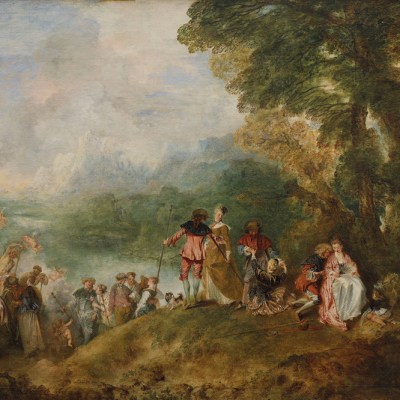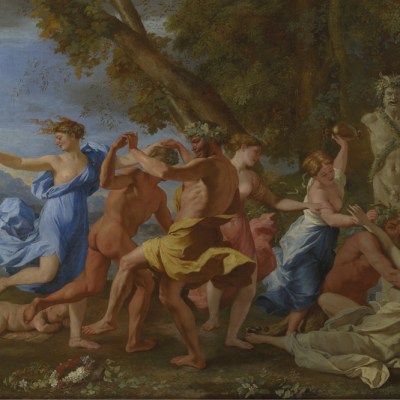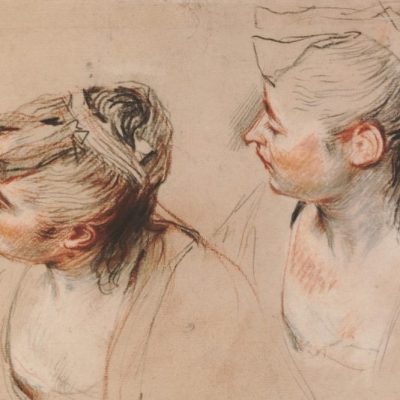From the July/August 2025 issue of Apollo. Preview and subscribe here.
I first came to the Dulwich Picture Gallery, where Les Plaisirs du bal is, with Keats in mind. I was working on Keats and knew that some of his friends thought that the Rembrandt portrait of Titus in the newly opened gallery resembled him. The excitement generated by this collection – the first accessible to the general public when it opened in 1817 – was surely comparable to the buzz around the Parthenon marbles at the British Museum the previous year. William Hazlitt, an early and enthusiastic visitor, advised his reader to approach the gallery in winter, the better to appreciate ‘the bloom, the burning glow of beauty that will fall upon his senses from the rich summer of Art which greets him on his entrance to this exquisite Gallery’.
‘Bloom’ and ‘glow’ are good words to bring to bear on Watteau’s Les Plaisirs du bal. Though the painting is full of marvellous depiction, a description of it in terms of subject matter feels wide of the mark. Is representational painting any more ‘about’ what it represents than a narrative poem is ‘about’ its story? Often the story or what is represented exists as an armature that permits something more subtle to exist – in the way of a dream-catcher whose web is intended to catch what fleets through it, or a back-lit sheet, pegged out in the night to catch moths. Baudelaire saw not moths but incandescent, drifting butterflies in Watteau’s work, ‘où bien des coeurs illustres/Comme des papillons, errent en flamboyant’ – ‘Where so many illustrious hearts/like butterflies, wander ablaze.’
The quality of Les Plaisirs du bal is hard to get. When Charles Leslie showed a copy he had made to his friend John Constable he was told, ‘Your Watteau looked colder than the original, which seems as if painted in honey, so mellow, so tender, so soft, and so delicious […] this inscrutable and exquisite thing would vulgarise even Rubens or Veronese.’ Watteau’s many imitators, including Nicolas Lancret and Jean-Baptiste Pater, try to find a formula and in so doing, fail.
Les Plaisirs du bal (The Pleasures of the Ball), (c. 1715–17), Antoine Watteau. Dulwich Picture Gallery, London

What is this quality? It has, I think, to do with evenness. While there is a great deal going on in this painting – private conversations, approaches, embraces, repulses, music heard (by one dog in particular) or ignored in favour of talk – there is no sense of priority. All the distinguishing – the painting is full of particularity – is done by the light and there is a sense that where the light falls now is not where it will always fall. The light that seems to come from the front left picks out the folds of the dress of the woman whose back is turned to us, the left calf of her dancing partner, glass and silverware, the knees of a woman to the right. The light is impartial. Though most of the people appear to be toffs, the spirit is democratic. Below the turbaned man (straight from Veronese) looking down over a balustrade are the unilluminated but visible dark-clothed figures of musicians and guests. Taken alone this passage of painting could almost be from a theatre painting by Sickert: the dun shades when the light is elsewhere.
Towards the back, in a direct line from the presumed gaze of the dancing woman and perhaps as much in her sights as her partner, is a fountain, expressed as a shower of brightness. Back again, more figures – tiny ones in a distant scene which, approached more nearly, might prove as haunting as that in Giorgione’s Tempest. As with a theatrical gauze which can be either opaque or translucent (revealing further scenes) according to how light is directed, there is no sense of finality about what is visible, but a suggestion that there is always more. The light is here but might just as well be there. Perhaps because I come to this painting with the gallery’s first visitors in mind – Hazlitt, Constable and other Academicians, the poets of the 1810s – I think of Keats’s ‘favourite Speculation […] that we shall enjoy ourselves here after by having what we called happiness on Earth repeated in a finer tone and so repeated’. ‘Tone’ and ‘quality’ are more helpful to me in thinking about this work than ‘subject matter’ and ‘story’. The elusive quality of this painting reminds me of the harmonic notes on a stringed instrument, created by a sure touch which affects but does not depress the string. Some of the joy that this work imparts comes from this sensitive tact; its complete absence of coercion.
From the July/August 2025 issue of Apollo. Preview and subscribe here.


